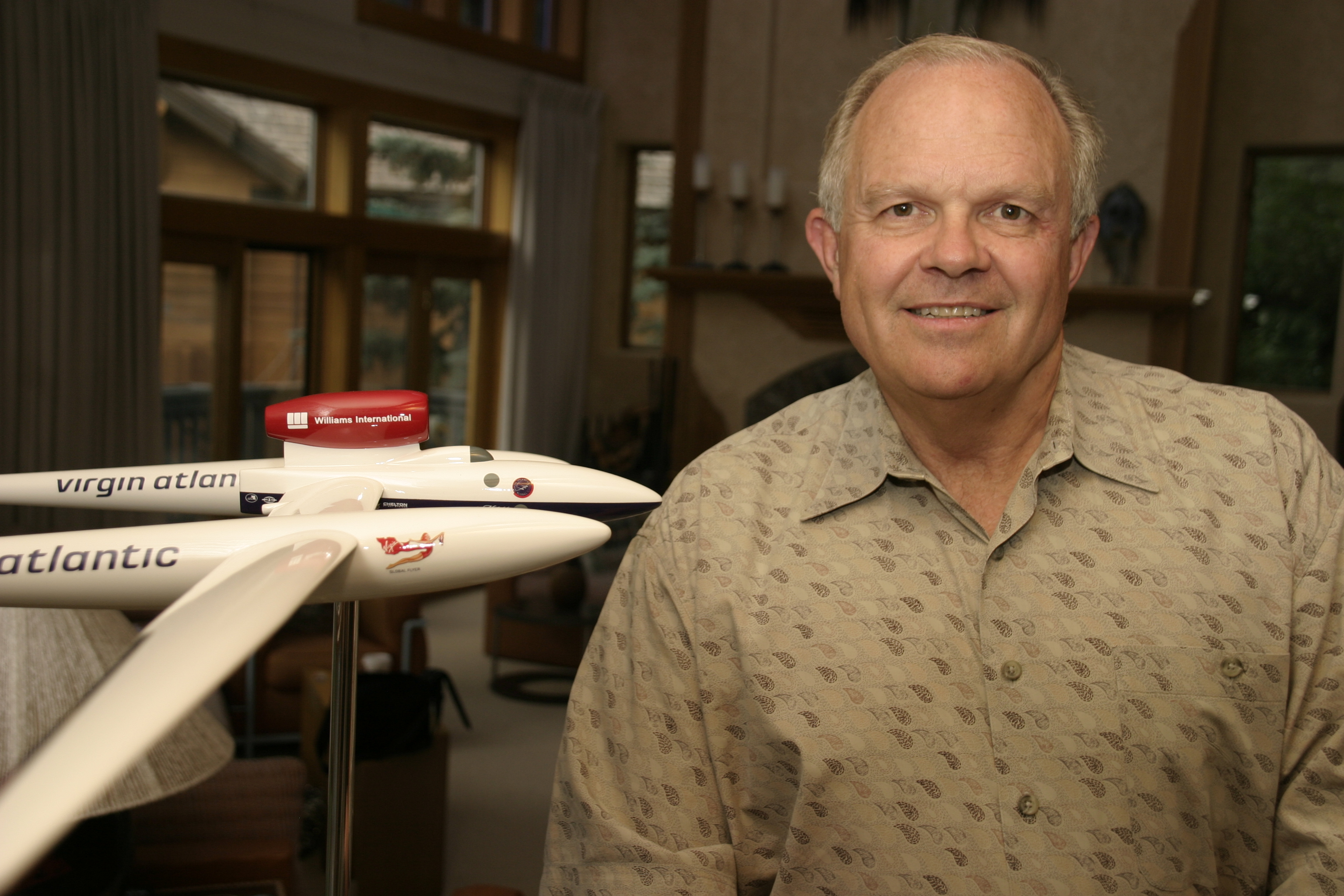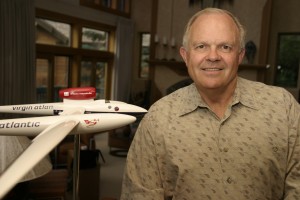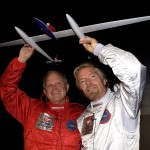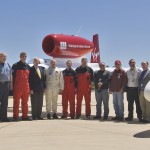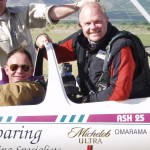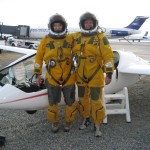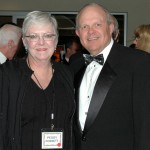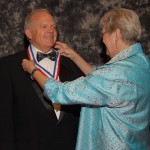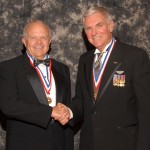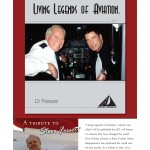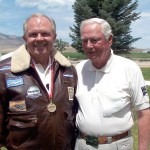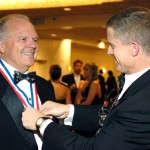|
By Di Freeze
It’s a beautiful day in Beaver Creek, Colo., and, for once, Steve Fossett isn’t making history. On this day, he’s relaxing in his spacious, contemporary Colorado home in Beaver Creek, talking about his colorful past. As he delves into the past, he reveals that “diversity” is the most interesting aspect of his adventure sports history. He counts off five sporting categories in which he’s set world records: sailboats, powered aircraft, balloons, airships and gliders. “Most people get a world record in one sport,” he said. “In aviation, for instance, there are absolute world records in the various classes of aircraft. No one had ever held an absolute world record in more than one class of aircraft. I do now, in four classes of aircraft.” Fossett has made five world record nonstop circumnavigations of the Earth: as a long-distance solo balloonist, a sailor and a solo airplane pilot. He’s set 88 aviation world records ratified by the Fédération Aéronautique Internationale, plus 23 sailing world records ratified by the World Sailing Speed Record Council. Fossett details his many adventures in his new book, “Chasing the Wind: The Autobiography of Steve Fossett,” released in 2006 by Virgin Publishing. Although he carefully chose the name for his autobiography and said he’s definitely been able to “play off the wind,” Fossett added that not “all” of his adventure goals have been related to the wind. “There’s a transfer of knowledge from one sport to another,” he said. “I’ve learned to work with meteorologists very well. I know the right questions to ask, I understand the charts they’re showing me and I can make the right decisions, with their advice. That mode of operation has brought me success in multiple sports. If I had to go to college again, I’d major in meteorology.” |
|
These days, Fossett divides his time between Beaver Creek and Carmel, Calif. His life started out in Tennessee, however. He was born in Jackson, on April 22, 1944, but grew up in Garden Grove, Calif. His father, an Eagle Scout, encouraged his son’s adventurous nature when he introduced him to Boy Scouts.
“He made sure I joined the very first day I could, when I turned 11 years old,” Fossett said. “That was the most significant activity in my youth.”
Fossett earned his Eagle Scout badge in 1957.
“I’m still very involved,” he said. “I’m on the national board and also the international board, the World Scout Committee.”
Mountain climbing was his first sport; the first mountain he conquered was San Jacinto, the third highest mountain in the state.

Steve Fossett has set official world records in five different sporting categories: sailboats, gliders, balloons, powered aircraft and airships.
“I climbed my first mountain when I was 12 years old, and continued on,” Fossett said. “Over the years, I climbed in expeditions to various places in the world.”
When Fossett began attending Stanford University, he hadn’t decided what he was going to do with his life.
“In those days, a lot of people aspired to get into politics. I was the president of various clubs and student body officer. I was involved in various leadership positions. Back in those days, I think I might even have been a good speaker,” he laughed. “But I recognized that wasn’t a logical pursuit for me.”
After graduating from Stanford in 1966 with a BA, Fossett went to the School of Business, Washington University, St. Louis, Mo. He graduated in 1968 with an MBA.
“For the first five years of my business career, I was distracted by being in computer systems; then I became interested in financial markets,” Fossett said. “That’s where I thrived.”
While in computer systems, Fossett started with IBM, and then worked for Marshall Fields. In between, he worked for Deloitte Touche as a consultant.
He began dabbling in finance and in 1980, built a trading firm based, Lakota Trading Inc., in Chicago.
“I was on the floor of the exchanges for 15 years,” he said. “Five years later, I started hiring people to build the company. We were on exchanges throughout the United States and one time, even London.”
Fossett was highly successful as a floor trader.
“It was a natural for me,” he said. “I’m a very competitive and methodical person. Those two aspects are key to being successful in financial trading.”
More mountains and swimming the English Channel
In the half-dozen or so years after graduating, Fossett had little time for sports. But he began missing the “interesting things” he had done in high school and college.
“There was a period where I wasn’t doing anything except working for a living,” he said. “I became frustrated with that and finally made up my mind to start getting back into things. I resumed mountain climbing, ran marathons and did cross-country ski races—distance races—and car racing.”
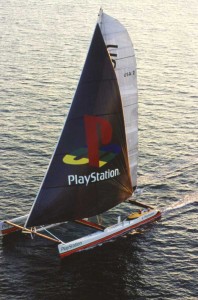
Steve Fossett had PlayStation (later renamed Cheyenne) built to attack the major sailing records. He twice set the prestigious 24 Hour Record of Sailing and set a transatlantic record with the large catamaran.
A friendship led him to climbing some important mountains in the early 1980s.
“Pat Morrow was trying to be the first person to climb the Seven Summits,” he said. “He did it, back in 1985. I climbed the last three mountains with him.”
With Morrow, he climbed Vinson in Antarctica, Carstenz in Australasia and Elbruz in Europe. Fossett eventually climbed six of the summits. One mountain Fossett didn’t conquer was Everest. He withdrew from climbing the mountain in 1992, due to problems was asthma.
Fossett said people take up mountain climbing for the same reason others might begin scuba diving.
“They get to go to great locations; it’s a good excuse to travel,” he laughed. “Mountain climbing also takes us to very interesting parts of the world. I did two expeditions to Antarctica, Greenland, all the continents. That was fascinating.”
Fossett’s first major sports project was swimming the English Channel, in September 1985, from France to England.
“It was the first time I planned a project; it involved figuring out how to do something and then training,” he said. “That characterized my approach to other projects—a lot of planning and preparation. It wasn’t easy for me, because I’m not a very good swimmer. I was never good enough to make the varsity swim team. But I found that you can just keep going in swimming; you can swim a long time. It took me four attempts over a period of five years before I finally succeeded.”
For his first attempt, he trained for two months, swimming a mile every day.
“On subsequent attempts, I figured the system out, and I didn’t have to train quite that much. Predictably, it was an extremely slow swim. I won the endurance trophy that year,” he laughed. “That’s awarded to the person that makes the year’s slowest swim across the English Channel.”
The 270th person to swim the English Channel, Fossett accomplished his crossing in 22 hr, 15 min.
“The success rate is quite low,” he said. “It was only 10 percent back when I was doing it. I suspect nowadays, with all the good swimmers in the world, it’s much higher.”
The multimillionaire’s financial success eventually gave him the flexibility to decide how much time he wanted to devote to business and how much to sports.
“At first, I’d do about six weeks a year on adventure sports, like climbing expeditions,” he said. “Eventually, I decided I no longer wanted to maximize my business career. In 1990, I moved from Chicago to Beaver Creek, with the realization that I couldn’t maximize my business career living here, but I could keep my company going.”
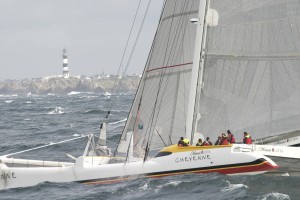
As the skipper of Cheyenne, Steve Fossett set the world record for fastest circumnavigation around the world in 2004. The official start/finish line of the World Sailing Speed Record Council is at the French island of Ouessant.
Since moving to Beaver Creek, Fossett estimates he’s spent half of his time on adventure sports and the other half on his business, still headquartered in Chicago.
Iditarod, Le Mans and Ironman Triathlon
Fossett stayed active in climbing, but his next big adventure was competing in the 1992 Iditarod Dogsled Race, covering a course of 1,165 miles.
“That was perhaps the most fascinating thing I’ve ever done,” he said. “It took me five years, from the time I started dog sledding until I finished the Iditarod. Going up to the Yukon and Alaska to train dogs was interesting in itself.”
The idea surfaced while Fossett was at a British base in Antarctica.
“They had dog teams back then, and we started talking about it,” he recalled. “One of the guys on the climbing expedition said, ‘I know somebody who just won one of the major races. Maybe he’ll teach you how to do it.’ I was introduced, went up to the Yukon and started learning the sport.”
Fossett finished 47th out of 76 starters.
“I was delighted to finish,” he said. “I never did another dog-sled race after that. If you want to be competitive in the top 10 positions, you need to devote your life to that—live up there and have your own kennel of race dogs. That wasn’t what I wanted. I wanted the experience of finishing the race.”
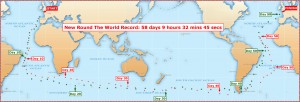
Steve Fossett began his 2004 round-the-world voyage on Feb. 7 and completed it on April 5. His time—58 days, 9 hr, 32 min, 45 sec—broke the previous record by nearly six days.
In the mid-1970s, Fossett had been involved in various forms of race car driving. He started driving again in the early 1990s. That eventually led to driving the 24 Hours of Le Mans in 1993 and 1996.
“I finally concluded that I’d do best at endurance style racing. I can be very consistent; maybe I can’t be quite as quick as the professional drivers, but in endurance racing, the object is to not lose the car, spin out the car or crash the car,” he laughed. “I found that the top professional drivers made more mistakes than I did, so I felt that was an equalizing factor—that I actually had a chance to compete against the top drivers in an endurance race, where I couldn’t compete with them in a short race.”
He didn’t win, but he proved his theory in other ways.
“I didn’t have any really high placings,” he said. “I took a fourth place at Sebring, once. But I enjoyed it. Also, normally you have three drivers per car, and you trade off; drivers might drive one hour at Le Mans, for instance. Once I drove for four and a half hours. They didn’t call me in to pit because, rather than deteriorating from being tired, which is what you’d normally experience, I’d improve. I was getting more in the groove and wasn’t getting tired.”
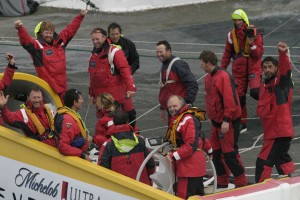
Steve Fossett and a crew of 12 sailed around the world on Cheyenne, achieving the most important record in sailing.
He said that in all of the early sports activities, he played off the concept of endurance.
“People can do endurance events with just the necessary preparation and training,” he laughed.
Fossett has run several marathons, including major races in Boston and New York and the Leadville 100 in Colorado. Since he also enjoys cycling and “can get through the swimming,” another goal was to enter a triathlon. He competed in the Ironman Triathlon in Hawaii in 1996.
“I managed to get an invitation to go in the Ironman, which is an experience in itself,” he said. “There are 1,500 people in the race, and it’s a whole culture of people who love to work out, and they spend their lives doing that.”
His Colorado home provided the setting for two cross-country skiing records. He set an Aspen to Vail record (59 hr, 53 min, 30 sec) in February 1998 and an Aspen to Eagle record (12 hr, 29 min) in February 2001.
Sailing
After moving to Beaver Creek, Fossett decided he particularly wanted to do two things.
“One was to sail a boat across the Atlantic, single-handed, and the other was to fly a balloon around the world,” he said. “I started from scratch on those two projects in the early ’90s.”
Fossett would eventually set 21 outright sailing world records. He learned how to sail when he was still in his twenties, but his first sailboat race wasn’t until July 1993.
“It was a two-handed race around Britain and Ireland,” he said. “It was a 2,000-mile race, and we won it.”
He set his first world record in September 1993, sailing around Ireland. The record stands at 44 hr, 42 min.
Fossett set three single-handed records: the Pacific Ocean world record, Yokohama, Japan, to San Francisco (20 days, 9 hr, 52 min), Aug. 5-24, 1996; Newport, R.I., to Bermuda world record (40 hr, 51 min, 54 sec), June 1999; and Transpac, San Francisco to Hawaii (7 days, 22 hr, 38 min), June 27-July 5, 1999.
He also established nine sailing distance race records. He accomplished his goal of sailing a boat solo across the Atlantic when he competed in single-handed sailing’s most important race, the Route de Rhum, Nov. 6-10, 1994. He placed fifth overall.
“I competed mainly against the great French single-handed sailors,” he said. “I didn’t win that race, but it surprised the professional sailors that I could do that well.”

Fossett made five solo round-the-world attempts between 1996 and 2001, before accomplishing his goal of setting the absolute RTW speed record. He made his first attempt in the Solo Challenger and his second through fifth attempts in Solo Spirit (shown).
In a race from Newport to Ensenada, Mexico, in April 1998, he established the world’s fastest yacht race record: 6 hr, 46 min, 40 sec, at 18.45 knots.
After owning two sailboats, Fossett had a large catamaran built for the purpose of attacking the major sailing records. PlayStation (later renamed Cheyenne), designed by famed multi-hull architects Gino Morrelli and Pete Melvin, was launched in 1998. The catamaran was constructed entirely out of carbon fiber.
With PlayStation, Fossett twice set the prestigious 24 Hour Record of Sailing, 580 miles in March 1999 and 687 miles in October 2001. He set a transatlantic record (4 days, 17 hr, 28 min, 6 sec), Oct. 5-10, 2001, at 25.78 knots, from New York to England. That record was one of his best, and stood until July 2006.
Fossett and a crew of 12 sailed around the world on Cheyenne from Feb. 7 through April 5, 2004. The voyage set the world record for fastest circumnavigation around the world (58 days, 9 hr, 32 min, 45 sec), breaking the previous record by nearly six days.
Fossett retired from sailing in 2004.
“It was a very successful program,” he said. “I broke most of the important world records. In a couple of cases, my records were broken, and I went back and re-broke them. But then, I finally decided, ‘I’m not going to make a career out of defending my records.’ After getting the biggest record, the around-the-world record, I considered my sailing career complete.”
Fossett estimates that about half of his 23 records still stand.
“They’re getting broken one at a time,” he said.
Ballooning
Before becoming seriously involved in ballooning, Fossett first had to find the most reliable long distance balloon with the most proven equipment. He chose a Cameron (77,000 cubic feet), a design used for the 1992 Transatlantic Balloon Race. One problem he had to overcome was that balloons at that time had no working autopilot.
“You had to have it to fly solo,” he said. “One of my team members, Bruce Comstock, developed the first workable balloon autopilot. Once he had done that, then it became possible.”
Fossett’s first major balloon adventure was a transatlantic flight from St. John’s, Canada, to Hamburg, Germany, made Aug. 18-21, 1994. Tim Cole was his copilot.
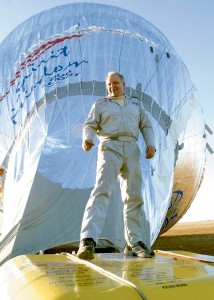
After five previous attempts, Steve Fossett successfully completed the first round-the-world solo balloon flight in 2002. He left Northam, Australia, on June 19, and landed in Queensland, Australia, on July 4.
“Then I decided I might know enough to fly solo,” he said.
The following year, he made the first solo balloon flight across the Pacific, beginning in Seoul, Korea, on Feb. 17, 1995, and landing in Mendham, Saskatchewan, Canada, on Feb. 21. On that flight, he set an absolute world distance record of 5,435.82 miles.
Out of all of the records Fossett has set, he believes the first solo round-the-world balloon flight is still the most important.
“It was a grandiose project,” he said. “It took seven years. We not only had to fly it, but we also had to develop the technology to fly at great durations and distances.”
Although other balloonists had their eyes set on the same goal, initially Fossett was the only one who planned to go solo.
“In aviation, there’s something about solo flights that carries more significance than crewed flights,” he said. “Alcock and Brown (Capt. John Alcock and Lt. Arthur Whitten Brown) made the first transatlantic flight in 1919, yet we don’t hear much about them. But, eight years later, Charles Lindbergh made the first solo flight, and it was highly significant. This pattern has repeated itself in the history of aviation.”
Fossett thought he was the right person to do a solo flight.
“I knew how to do all the functions on the balloon, including navigation, and I was used to the endurance aspects of living in high-altitude environments, over 20,000 feet, for a couple of weeks at a time, because of my mountain climbing experience,” he said.
He also had practical reasons for wanting to go solo.
“Flying solo makes the equipment much lighter,” he said. “You’re supporting the weight of only one person and personal supplies. I thought that was significant.”
Fossett had another big reason to go solo.
“Being a newcomer to the sport, I didn’t want to be perceived as ‘the rich guy flying with an expert,'” he said. “I wanted to be perceived as a balloonist myself, capable of doing it.”
Between 1996 and 2001, Fossett would make five solo round-the-world attempts before achieving his goal, with an absolute RTW speed record.
“When I was first flying balloons, the distance record was 5,200 statute miles. I had to fly 22,000 miles to get around the world, and the longest duration anybody had flown a balloon was six days,” he said.
It was thought that flying around the world would take about 24 days.
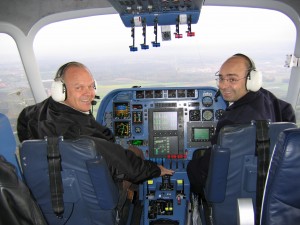
Steve Fossett is one of only 17 Zeppelin captains in the world. In October 2004, he set an absolute world speed record for airships of 71.5 mph, in a Zeppelin NT. His copilot was Hans-Paul Stroehle (right).
“In order to fly around the world, we had to more than quadruple the capabilities of what had ever been done before,” Fossett said. “A lot of equipment development needed to take place, by myself and my competitors. We sometimes benefited from each other’s technological development.”
For his first solo RTW attempt, Fossett and the Solo Challenger departed Stratobowl, S.D., on Jan. 8, 1996. He landed at St. John, Canada, approximately 2,200 miles, on Jan. 11.
His second through fifth attempts were made in Solo Spirit. On his second attempt, he departed St. Louis on Jan. 13, 1997. He landed at Sultanpur, India, Jan. 20, setting an absolute world distance record of 10,360.61 miles, as well as an absolute world duration record of 6 days, 2 hr, 44 min.
On his third attempt, Fossett again departed St. Louis, on Jan. 1, 1998, but this time traveled 5,802.94 miles to Grechanaya, Russia. Each attempt resulted in improvements for Fossett and his team.
“Then, once again, I’d be surprised to find out that we didn’t have it all together yet,” he said.
By 1998, the ballooning world knew it had gotten to the point where it was possible to fly around the world. Fossett had decided to try a new strategy; he was going to fly in the Southern Hemisphere.
“I was becoming frustrated with the permission problems of the Northern Hemisphere,” he said. “Some of these countries represent a bona fide danger. You ran the risk of being shot down if you flew over Libya without permission, for instance, or flew low enough over various countries, where surface-to-air missiles could reach you. Then, the jet stream goes directly through China. No one’s ever gotten permission to fly the main jet stream core through that area.”
He decided to take advantage of crossing only four politically-friendly countries—Argentina, Australia, New Zealand and Chile.
“I believed that the jet streams, the wind patterns, would be smoother and more reliable, because you’re crossing oceans,” he said. “The downside of the Southern Hemisphere is you’re over water most of the time, and you’re off the main shipping routes. If you go down, your life would be at risk. If your balloon went down in more than half the Southern Hemisphere route, it wouldn’t be possible to rescue you. In the Northern Hemisphere, you’re within reach of rescue almost 100 percent of the time.”
Fossett set off on Aug. 7, 1998, from Mendoza, Argentina, on his fourth attempt. Things were going well until Aug. 16, when a violent thunderstorm ended his flight. His balloon ruptured, and Fossett fell 29,000 feet into the Coral Sea, 500 miles east of Australia.
Fossett said that by cutting fuel tanks loose 1,000 feet above the water, he was able to soften the impact. He was unhurt in the landing, but the capsule quickly caught fire, capsized and submerged. With his emergency beacon and life raft, he dove through the hatch into the ocean and floated until a rescue plane from New Caledonia spotted him the next morning. The Australian schooner Atlanta picked him up 24 hours after the crash.

GlobalFlyer designer Burt Rutan (left) and pilot Steve Fossett visit before a media briefing at EAA AirVenture Oshkosh 2005.
“I was having the most success in the distance flights for five consecutive years; I made the longest flight in the world,” he said. “I felt I was the leader in the competition. But I lost all my equipment when I went down in that storm.”
The 14,235.33-mile flight resulted in an absolute world distance record. In December 1998, Fossett took a break from his attempt to make a solo RTW balloon flight and joined Richard Branson and Per Lindstrand in their ICO Global Challenger attempt.
“I didn’t have time to rebuild a set of equipment and Richard had wanted to get me on his team. We made a very nice flight, more than halfway around the world, from Marrakech, Morocco to Honolulu—or near, just offshore,” he laughed.
That 12,403.07-mile flight began Dec. 16 and ended Dec. 25. A few months later, the race to fly a balloon nonstop around the world was over. On March 1, 1999, Bertrand Piccard and Brian Jones set off in the Breitling Orbiter 3 from Chateau d’Oex, Switzerland. They landed in Egypt 19 days, 21 hr, 47 min later, after traveling 25,361 miles, 477.47 hours aloft.
Fossett wouldn’t be the first to fly a balloon around the world, but it still intrigued him to make the first solo flight. Not wanting to be perceived as making the “second” flight around the world, he decided to wait until 2001. His fifth solo RTW attempt began in Northam, Australia, August 5, and ended Aug. 17 at Bagé, Brazil. The duration of 12 days, 12 hr, 57 min, set a new solo flight record.
Fossett began his sixth and final attempt on June 19, 2002, from Northam, flying the Bud Light Spirit of Freedom. At one point, he had to hand-fly the balloon at less than 500 feet, in order to avoid high winds at altitude. He had a few other tense moments, but on July 4, 2002, he landed in Queensland, Australia, successfully completing the first RTW solo balloon flight. The time on the 20,626.48-mile flight was 13 days, 8 hr, 33 min (14 days, 19 hr, 50 min until landing). A 3,186.80-mile portion of the flight, from June 30–July 1, also established a 24-hour record for speed.
Flying the Zeppelin
Fossett is one of only 17 Zeppelin captains in the world. He received his license to fly the Zeppelin in Germany.
“I had to get a German pilot’s license and basically a type rating in the Zeppelin,” he explained. “In order to set a record, you can’t be a student pilot; you have to be a qualified pilot in command.”
In October 2004, Fossett set an absolute world speed record for airships of 71.5 mph in a Zeppelin NT.
Fixed wing records
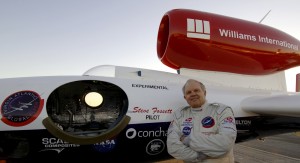
Steve Fossett achieved the first solo nonstop RTW speed record in the GlobalFlyer, in 2005. He made the 22,936-mile flight in 67 hr, 1 min, 10 sec.
Fossett got his fixed wing private pilot’s license in 1967. After flying a Falcon 10, he moved up to a Cessna Citation 10, in which the jet pilot has set transcontinental, Australian transcontinental and round-the-world westbound non-supersonic records.
“The Australian transcontinental record is the fastest of any kind of aircraft to cross Australia,” he said. “It’s Perth to Brisbane. I did that while I was waiting for one of my balloon flight launches. We flew to Brisbane and back the same night to Perth. We waited a couple days, and when the balloon weather still wasn’t any good, we did a Perth to Hobart, Tasmania.”
He made the trip from Perth to Brisbane July 28, 2001, at 705.06 mph, to set the unlimited Australia transcontinental record; the flight from Perth to Hobart set the fastest unlimited world record by a non-supersonic airplane, at 742.02 mph, July 30, 2001.
Fossett said success was due to good weather forecasting, as well as running the Citation 10 right on its maximum speed.
“With the Citation 10, while flying low—41,000 feet—you can fly at .92 mach,” he said.
Fossett established several U.S. transcontinental records. On Sept. 17, 2000, he set an east to west non-supersonic record from Jacksonville, Fla., to San Diego, at 591.96 mph (3 hr, 29 min, 35 sec). On Feb. 5, 2003, flying from San Diego to Charleston, S.C., he set a west to east non-supersonic record, at 726.83 mph (2 hr, 56 min, 20 sec).
“The SR-71 holds the absolute record,” he said. “Two hours and 56 minutes is still a pretty good time though, across the United States. The fastest anybody had done it before was three hours and 32 minutes, a couple of years earlier.”
Fossett set round-the-world records in the H-Class (medium airplanes) as well. He set an eastbound record on Feb. 16, 2000 (559.89 mph) and a westbound record on Nov. 24, 2000 (500.56 mph).
Other airplane world records include LA-Honolulu (unlimited), 4 hr, 11 min, 5 sec, 609.84 mph, March 23, 2000; 200 km speed record (H-Class), 598.26 mph, Nov. 26, 1999; 5000 km speed record (H-Class), 572.29 mph, July 14, 2000; Goose Bay-Berlin (unlimited), transatlantic record/non supersonic airplanes, 649.93 mph, Oct. 8, 2003.
The GlobalFlyer

On Feb. 11, 2006, Steve Fossett broke the airplane nonstop global flight distance record of 24,986 miles, set by Dick Rutan and Jeana Yeager in December 1986 aboard Voyager.
Looking back at his accomplishments, Fossett laughed and said he’s missed a few chances. After Piccard and Jones made their historic flight, conversation at dinner at Barron Hilton’s Flying M Ranch in southern Nevada one night turned to serious thought. The main subject: “What’s the most important thing that hasn’t yet been done in aviation?”
“Dick Rutan, who did the first two-person nonstop flight around the world, believed it was now possible to do a solo nonstop RTW flight,” Fossett recalled. “He said his brother had a preliminary design concept, so I asked Dick to introduce me. I met Burt at Oshkosh in 1999.”
Although Fossett had his mind on the “last great aviation record,” once they began talking, Burt Rutan, who heads Scaled Composites, had two proposals for Fossett.
“One was the solo airplane. He told me, ‘But what you really ought to do is the first private spaceship.’ He thought that was the most important thing to do. He estimated it would cost $2 million to do the solo around-the-world airplane, but it would cost $7 million to do the private spaceship. Thinking back on that, I should have done them both!” Fossett exclaimed. “Paul Allen took the spaceship, and it was a huge success. But I’m a pilot, and the reason I wanted to do the GlobalFlyer project was to fly it, not to own it.”
On Oct. 4, 2004, SpaceShipOne secured the $10 million Ansari X Prize when it rocketed into history, becoming the first private manned spacecraft to exceed an altitude of 328,000 feet, twice within the span of a 14-day period. Although Mike Melvill was at the helm that day, Fossett does have a close association with the project. He became one of the owners of Scaled Composites in the project’s early stages.
Fossett said that the GlobalFlyer project, eventually sponsored by Sir Richard Branson’s Virgin Atlantic, was slow to get started. Although Rutan knew how to design the airplane, they needed a fuel efficient jet engine and an autopilot.
“We considered a fuel-efficient military jet engine that was developed as a result of the oil crisis in the 1970s,” he said. “But it was in a box. We were nervous about being able to support a jet engine no longer being flown.”
Dr. Sam Williams, of Williams International, offered a production jet engine.
“It’s currently being put on airplanes like the Raytheon Premier One,” he said.
Their last hurdle was to find the right autopilot.
“We wanted a digital autopilot,” he said. “Only a couple of companies were making them. One of them wouldn’t quote on it; the other one was TruTrack in Arkansas. We flew out there the day after Christmas in 2000. They had the right autopilot that could be modified for this purpose. That’s when I pushed the ‘go button.’ I think it was a year before we actually started building.”
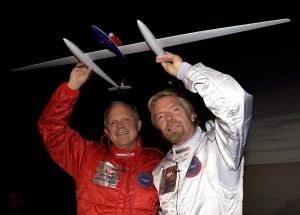
GlobalFlyer sponsor Sir Richard Branson (right) helps Steve Fossett display a model of the record-breaking aircraft.
Although Burt Rutan came up with the concept, Fossett said the most significant person in the development of the GlobalFlyer was Scaled Composites’ John Karkow.
“He designed and managed the building of the plane and was the test pilot,” he said. “After it was built and a number of test flights had been done, I started doing test flights too.”
With wings stretching 114 feet, the trimaran-shaped body of the GlobalFlyer spans only 44 feet. It weighs only 3,460 pounds, due to exclusive use of graphite/epoxy materials, and requires only a single jet engine (Williams FJ44) to power it to a cruising altitude of 51,000 feet, at speeds in excess of 285 mph. Learning to fly the GlobalFlyer was an experience.
“Obviously, the first time you get to fly it is solo,” he said of the single-passenger craft. “I worried about how to prepare. I finally concluded the best we could do is figure out what the speeds and the glide path would be in the GlobalFlyer, and, based on the engineering, how it would fly. Then, we’d use those same parameters in Mike Melvill’s Long-Eze. I flew with Mike, practiced the glide slope and the speeds and got that down. That same day, I got out, got in the GlobalFlyer and flew it.”
Speeds had been calculated correctly, and he quickly realized that the GlobalFlyer handled well and landed easily.
“You don’t want any surprises when you’re in flight,” he said. “I felt very secure in the GlobalFlyer.”
Fossett confirmed that the GlobalFlyer is more like a glider than a powered airplane.
“But then you add on characteristics of a jet engine, so my experience flying Citations was also relevant in understanding the plane,” he said.
Rutan and others at Scaled Composites leaned toward Fossett flying from Edwards Air Force Base in California.
“I wanted to fly from the middle of the U.S.,” Fossett said. “If I started at Edwards and flew eastbound around the world, I’d risk running out of fuel after passing over Hawaii, ending up in the water, and losing the plane. If I were to run out of fuel over the continental area of the U.S., the airplane has a 32-to-one glide ratio—similar to a standard performance glider—so I could fly more than 300 miles without an engine and basically land anywhere.”
Fossett reasoned that starting in the middle of the U.S. gave him time to ensure the airplane was working correctly before he got out over the Atlantic.

After the arrival of the record-setting airplane at the Steven F. Udvar-Hazy Center, May 23, 2006, Steve Fossett (fifth from left), poses with J.R. “Jack” Dailey, NASM director (fourth from left), museum staff and GlobalFlyer’s ground crew.
“It also would give me the final 1,500 miles over land on the finish,” he said. “My first idea was Salina, Kansas, because it has a long runway. I brought the idea up to the airport manager, Tim Rogers. He made sure I got everything I wanted—from the city, the chamber of commerce and Kansas State. Its aviation school is at Salina Municipal Airport. They immediately got the students involved.”
Four professional pilot students joined in flight planning, and seven of the A&P maintenance students helped in the maintenance and preparation of the aircraft.
“Everybody loved it,” Fossett said. “I got all the help I wanted and a huge hangar. By happy coincidence, they had planned to repave the runway just in advance of my flight.”
Planned for January 2005, the flight was delayed more than a month due to turbulence.
“I want the good winds, but when the jet stream is overhead, it will often create turbulence, especially if there’s a curve in the jet stream,” he explained. “The GlobalFlyer is vulnerable to turbulence; when it’s fully loaded, it’s considered to be good only for two Gs. I waited until I could fly away from the jet stream in calm air, during my climb, and then rejoin the jet stream, after I burned off a little bit of fuel and got to higher altitude, where the turbulence is less. I eventually flew north of the jet stream, up to Newfoundland, Canada, and then south to join the jet stream.”
With 30 hours in the experimental aircraft, Fossett took off on Feb. 28, 2005, just after sunset. Several hours into his flight, he experienced an intermittent GPS failure for a two-hour period over Canada, but the GPS finally reengaged. On March 2, as the GlobalFlyer passed over China, and just as Fossett was ready to embark upon the most dangerous part of the route—the Pacific Ocean—it was determined that one-sixth of his fuel was missing. That calculation wasn’t easy to make.
“There are two different fuel recording systems,” Fossett explained. “One is just a regular probe system, like a car gas tank; a totalizer records the fuel that goes into the engine and gets burned. The totalizer system failed. The probe system is very inaccurate, because the reading depends on the angle of the airplane. I was almost halfway around the world before they were sure the plane actually lost a lot of fuel.”
It was discovered later that the loss had occurred during the first three hours of flight.
“The plane had lost fuel out of the fuel vents during my climb out; it lost 3,100 of 18,100 pounds,” he said. “For a plane that was designed just to make it around the world—with a thousand-pound reserve of fuel—it was bad to lose 3,100 pounds at the start. But there was a good weather pattern, and we flew every aspect of fuel efficiency we could, and we made it back around.”
At the time, however, it had to be determined if he should land earlier than expected. Hawaii was one consideration, but Fossett decided to continue to the California coast. With tailwinds helping, he landed safely at Salina at 1:50 p.m. on March 3, after three sleepless nights. He had achieved the first solo nonstop RTW speed record—an absolute record—flying 22,936 miles in 67 hr, 1 min, 10 sec, traveling at an average speed of 342.2 mph.
That summer, the Virgin Atlantic GlobalFlyer and SpaceShipOne/White Knight were two of EAA AirVenture Oshkosh’s biggest draws. Although the purpose of the GlobalFlyer was to make the first solo around-the-world nonstop flight, Fossett contemplated a flight to establish a record for longest distance.
“I didn’t actively consider it until after I landed the first solo,” he said. “If I hadn’t lost that fuel, I could’ve done the distance record in this plane. That required only fixing the fuel loss.”
On the distance flight, Fossett would have to do an ocean crossing at the end of his trip.
“The only way to do the distance record, if you want to fly the jet streams, would be not only to fly around the world, but to fly additional distance,” he explained. “If I started in California, I’d go around the world and then continue on to Florida, let’s say, for a finish; that wasn’t quite long enough. I decided I would take off from the East Coast of the United States, fly around the world and then cross the Atlantic a second time.”
As soon as word leaked out that Fossett was interested in going for the distance record, he received a special invitation.
“NASA Kennedy Space Center asked me, ‘Why don’t you do the flight from the space shuttle landing field?'” he recalled. “They want to promote the space shuttle runway for other uses after the shuttle’s retired, so they liked the idea of inviting a private party there to do a record. It gave me that East Coast location, although it’s very warm down there, and it’s hard to get enough wind to get your takeoff performance in warm conditions with a jet engine.”
The plan was for the anticipated 80-hour, 26,084-mile journey to end with a landing at Kent International Airport, Kent, England. After a three-week delay, waiting for an early morning temperature in the desired 45-degree range, Fossett left NASA Kennedy Space Center in Florida on Feb. 8, 2006. The 4,000-pound GlobalFlyer took off carrying nearly 18,000 pounds of jet fuel in 13 tanks and using more than 11,000 feet of the 15,000-foot runway.
On that flight, he again lost fuel when 750 pounds escaped from the venting system during takeoff. But he said the loss wasn’t as critical that time.
“The fuel was very close on that flight, but we knew exactly how much I had, and we could calculate that I had just enough to make it to the finish,” he said.
Fossett described the main flight overall as “very relaxing.”
“Until something really went wrong,” he laughed.
Even before reaching cruising altitude, a cockpit ventilation system broke down, driving interior temperatures to nearly 130 degrees. He encountered severe turbulence over Bhopal, India, causing the aircraft to shake and oscillate violently.
“The turbulence was so bad, I couldn’t maintain altitude or directional control,” he remembered. “I was really wondering if the plane would survive that; I thought a spar could break in the middle of the night. I was thinking, ‘Geez, if this thing breaks, I have to depressurize the airplane, get out and then parachute into India in the middle of the night.’ That would have been a really bad circumstance.”
Fossett slipped into his parachute to prepare to bail out, but was relieved when the airplane passed through the worst of the turbulence.
“It was a stronger plane than we thought,” he said.
On February 11, over Shannon, Ireland, Fossett broke the airplane nonstop global flight distance record of 24,986 miles, set by Dick Rutan and Jeana Yeager in December 1986 aboard Voyager. But he still had more excitement left. That day, while starting his descent for landing, the sole generator failed.
“I estimated I had 25 minutes left on my battery before everything in the cockpit was going to go dark,” he said. “I was descending out of 51,000 feet and had a long way to come down. I decided I better get this thing on the ground, so I ended up landing in Bournemouth, England, instead of Kent.
“That was dramatic. There’s a little canopy on the GlobalFlyer, where I sit up high on a pillow for takeoff and landing, so I can get good visibility. But that ices on a long flight, from condensation on the inside. Normally, after I’ve been flying high, I’ll do a descent, and when I get down below 10,000 feet, I have a lot of time for it to warm up. It clears up the ice, and I can see where I’m going. But in this emergency descent over England, I didn’t have time.”
When Fossett got down over Bournemouth International Airport, the canopy was still completely iced up.
“I was taking vectors from air traffic control and flew over the airport three times—big circuits,” he said. “Finally the ice cleared, and I came in for a landing.”
That’s when he found out that he had one flat tire and that the other had frozen brakes.
“I probably punctured the one on the takeoff and blew the other on touchdown,” he said. “I landed with two flat tires.”
He accomplished that flight of 25,766 miles in 76 hr, 42 min, 55 sec, establishing an absolute non-stop distance record. Although it wasn’t highly publicized, Fossett made another around-the-world flight March 14-17, 2006. Of the seven absolute world records in airplanes, he knew that the GlobalFlyer was capable of setting three. He had already taken care of speed around the world, as part of the solo, and the longest distance. Now, he had his eye on the absolute closed circuit distance record.
“The other four records aren’t suitable; three of them (speed) are held by the SR-71, and the MiG-25 holds the altitude record,” he said. “I thought, ‘Before I retire this plane to a museum, I should fly it for what it’s capable of doing and not retire it prematurely.’ Sponsors weren’t very interested, so I finally decided, ‘I’ll just do it.’ We got the plane back to Salina, Kansas, and got ready.”
For the longest closed circuit flight, Fossett had to fly around the world with extra diversions.
“It was a long flight,” he said. “In order to achieve the distance necessary to get the record, once I got to Japan, I had to get down to the equator, where the Earth is wider, and fly along the equator until I got closer to Mexico, then come up.”
The flight’s tense moments included another severe episode of turbulence over Bhopal and a brake problem on landing.
“I had to land in IFR conditions when I came into Salina,” he said. “I flew the approach in icy conditions.”
That flight established an absolute closed circuit distance record of 25,294 miles. On each of the GlobalFlyer flights, Fossett set three records in different categories, bringing his total count to 115 official world records. Although it had been suggested that the GlobalFlyer would be useful for research activities, particularly because of its capability for long and slow flight, Fossett was more interested in giving it to the Smithsonian.
“That was this plane’s destiny,” he said. “I didn’t want to risk wrecking it, now that it had done its primary records.”
Arrangements were made to exhibit the aircraft at the National Air and Space Museum’s Steven F. Udvar-Hazy Center in Chantilly, Va. On May 23, 2006, Fossett flew the Virgin Atlantic GlobalFlyer from Salina to Dulles International Airport.
“Most of the planes hanging in the Smithsonian aren’t capable of flying anymore,” he said. “The GlobalFlyer is at its prime. I had permission to do a low pass over the airport, and then I came around, landed and taxied up to the door of the museum and gave it to them.”
Gliding into the stratosphere
Fossett first got his pilot’s license for gliders in 1975, but never flew one until he started visiting Hilton’s ranch, a gliding paradise in northern Nevada.
“Hannes Linke got me back involved in flying gliders in 1995,” he said. “Eventually, through various people I met at the ranch, I got more serious about it and decided to pursue records in gliders.”
Fossett utilizes two ASH-25s and a DG-505 in that pursuit.
“We use the ASH-25 for speed and distance records,” he said. “It’s a high performance glider with a 60-to-one glide ratio. The DG is also a good performing glider, but it was more intended for the special purpose of the altitude record.”
He keeps one glider at Minden-Tahoe Airport.
“It’s one of the best glider bases in the country,” he said.
While in New Zealand making altitude record attempts, Fossett met glider pilot Terry Delore, who proposed they fly together.
“He wanted to be able to fly the best equipment and be associated with someone serious about this,” Fossett said. “I quickly recognized that as far as glider flying skills, he’s one of the best in the world.”
Over a two-year period, between November 2002 and December 2004, Fossett and Delore set 10 absolute open class world glider records for speed and distance.
On Aug. 29, 2006, Fossett set a new world glider altitude record with copilot Einar Enevoldson, a former NASA research pilot. The record was set in El Calafate, Argentina, in Perlan, a high performance research glider based on a German-built DG-505. Fossett and Enevoldson made the first glider flight into the earth’s stratosphere, reaching a height of 50,671 feet (15,447 m). It shattered the previous record, set in 1986 in California, by 1,662 feet (507 m).
Enevoldson served as project operations director and chief engineer of the flight, made in conjunction with NASA’s Dryden Flight Research Center at Edwards Air Force Base. The flight’s objective was to prove the possibility of achieving un-powered flight to tremendous altitude, by “surfing” from one mountain wave to another to increasingly greater height.
Beginning in 2002, first flights took place in the U.S., New Zealand and Argentina. The record-breaking flight took place primarily within a 60-mile radius of El Calafate, near the border of Argentina and Chile. After being towed to 13,000 feet, the men began their search for the lift required to achieve their goal, flying along the crest of the Andes and “surfing the mountain wave.” With outside temperatures falling as low as -57 degrees, Fossett and Enevoldson, wearing NASA spacesuits, warded off the cold inside the unpressurized tandem cockpit with helmets, hand muffs and foot heaters.
About four and a half hours into the flight, Perlan achieved the record altitudes first targeted by the project when it was conceived seven years earlier.
Visiting the past with Alcock and Brown
Fossett took part in another fascinating project, repeating the most significant flight made by John Alcock and Arthur Whitten Brown. He made the transatlantic flight in a Vickers Vimy, an open-cockpit, replica biplane.
“I got invited in on the project during its final stages,” he said. “This plane had done two other major flights. Back in the 1919/1920 range, there were three great flights by the Vickers Vimy. One was from London to Cape Town, Africa, and one was from London to Sydney, Australia; there were many stops. The third flight was the first nonstop across the Atlantic.”
With Mark Rebholz as his copilot and navigator, Fossett made the nonstop flight from St. John’s, Newfoundland, Canada, to Clifden, Ireland, in July 2005. Exactly following the original route and navigating by sextant, compass and chart, they completed the flight in 18 hr, 15 min.
“I was the flight controls guy,” Fossett said. “I hung on to the yolk and manipulated the rudders for 18 hours—13 in instrument conditions.”
Since Clifden has no airport, the men arranged to land on the Connemara Championship Golf Links.
“We landed on the 8th fairway,” Fossett said.
Breaking even
Fossett said no matter which sport he’s chosen, his goal has always been clear.
“I’m trying to make major achievements, especially in aviation,” he said.
Profiting from his adventures was never his intention.
“I’m just trying to break even on my projects,” he said. “I broke even on the entire ballooning project, after sponsorship, and I got most of the costs covered by sponsors in both the GlobalFlyer and the sailing projects. I’ve just had to jumpstart these projects with my own money.”
When it comes to ballooning, Fossett came out ahead financially.
“On my final balloon flight, we had contingency insurance,” he said. “A sponsor buys an insurance policy from one of the major insurance companies to pay a prize. An insurance company offered a $3 million prize for making the first solo balloon flight around the world, for the payment of a $500,000 premium. I knew my odds were a lot better than 6 to 1; I figured I had an even chance of succeeding. So I put up the half-million dollars and collected the $3 million prize. With that alone, I turned a profit on all of my balloon flights. That’s the one case where I actually made money.”
Fossett successfully attracts sponsors because they know that when he announces a project, he’s really going to do it. He’s also been prepared to complete the projects, even if it meant he was doing all the funding.
“I brace myself for that,” he said. “The eventuality of each project is that, if necessary, I’ll finish it without sponsorship. A lot of people who are dependent on sponsorship announce projects in hopes of attracting sponsors, but usually they don’t get any, and they never get off the ground.”
At times, Peggy, Fossett’s wife of nearly four decades, has probably wished one of her husband’s projects wouldn’t get off the ground.
“This isn’t what she would prefer. She doesn’t want me to do these things, but she’s very supportive. She’s probably more relieved now; my most dangerous activity was ballooning. Once that was finished, she was in a much better mood,” he laughs. “She got pretty involved in the GlobalFlyer project. She was there from the start to finish of those flights.”
It might not be much of a comfort to Peggy, but although Fossett acknowledges he gets involved in “risky” sports, he doesn’t go into these sports because he wants the risk.
“I’m not a thrill-seeker,” he said. “You won’t catch me bungee jumping, for instance. Risk is an undesirable aspect of my sports and something that must be carefully managed. I like to surprise people with doing something that’s perceived to be too dangerous and then pulling it off. But nevertheless, my efforts are primarily devoted toward reducing risk.”
Fossett believes two character traits have most helped with his accomplishments: self-confidence and persistence.
“Self-confidence that it’s possible to do these things,” he said. “With that self-confidence that even difficult tasks are possible, I’ve been willing to apply a great deal of persistence to actually get them done.”
He’s also aware of the virtues of a good team.
“I’ve had different teams with me in each field,” he said. “There’s very little overlap, because my teams are generally really top flight in those sports. I had excellent sailors with me and some of the best American balloonists on my balloon projects. All the way, I’ve had the support of top quality people.”
No plans to slow down
Fossett recently got his helicopter license, with the intent of setting an absolute world record in rotorcraft. In mid-October 2006, he announced plans to break the absolute land speed record; his hope is to exceed 800 mph.
Fossett recalled the excitement when the first supersonic record was set a decade ago. Englishman Andy Green set the current record of 766 mph on Oct. 15, 1997, driving Richard Noble’s twin-turbojet powered Thrust SuperSonic Car (SSC) in Nevada’s Black Rock Desert. Rolls Royce Spey afterburning turbojets, previously used in the British F-4 Phantom II, powered the car.
To bring the record back to the U.S., in 2006 Fossett acquired a car used by Craig Breedlove, five-time land speed record-holder, for an unsuccessful 1996/97 LSR campaign. That vehicle was the third of Craig Breedlove’s “Spirit of America” series challengers—originally designed to break Noble’s 1982 record of 633 mph.
He then set up a workshop in Sparks, Nev. Aerodynamicist Eric Ahlstrom became project director for the “Target 800 mph” team, charged with modifying the car, including the installation of a single after-burning GE J-79 turbojet, developing 22,650 lbs of thrust (45,200 hp) and formerly fitted to a USAF F-4 Phantom fighter-bomber.
Fossett planned initial low-speed shakedown runs to validate stability, handling and safety systems, starting at 200 mph, leading to the careful expansion of the envelope toward much higher speeds. He initially hoped to make his record-breaking attempt on a dry Nevada lake between July and October 2007. He considered Utah’s Bonneville Salt Flats for the attempt, but decided the land was too soft. After determining that the Black Rock Desert was too rutted, he applied for a special recreation permit in Eureka County, about 225 miles east of Reno. Fossett sought approval from the U.S. Bureau of Land Management to use a 15-mile-long dry lakebed in remote east-central Nevada. He recently announced that it would take some time to remove rocks from the dry lakebed and improve an access road.
Honors in abundance
Fossett’s efforts have resulted in numerous awards. He was inducted into the Balloon and Airship Hall of Fame (FAI-CIA) in 1997. In 1999, he received the Silver Buffalo, the highest volunteer award of the Boy Scouts of America, given to adults at the national level. After his solo balloon flight, he received the prestigious Gold Medal from the Fédération Aéronautique Internationale and the Explorers Medal from the Explorers Club. Other awards include the Diplôme de Montgolfier, Fédération Aéronautique Internationale (1996); Harmon Trophy, National Aeronautic Association (1998 and 2002); Rolex Yachtsman of the Year, U.S. Sailing Association (2001); Grande Médaille de l’Aéro Club de France, and Gold Medal, Royal Aero Club, United Kingdom (2002); and Order of Magellan, Circumnavigators Club, as well as Médaille de l’Aéronautique République Française (2003).
On July 21, 2007, in Dayton, Ohio, friend and fellow adventurer Dick Rutan presented Fossett with enshrinement in the National Aviation Hall of Fame. While making his presentation, Rutan discussed a major feat the two had in common.
“In 1986, I flew the Voyager around the world, without stopping and without refueling,” he said. “The duration of that flight—touted as aviation’s ‘last first’—was 9 days, 3 minutes and 44 seconds. I’ve always said records are set to be broken, as that proves progress. Little did I know that in less than two decades after my flight, someone like our next inductee would come along and shatter my time. Last year, this adventurer climbed into the cockpit of his GlobalFlyer and trimmed my 216-hour flight from 20 years ago to a mere 76 hours, 42 minutes.”
Rutan mentioned Fossett’s recent glider plane altitude record and his future plans to upset the land speed record.
“It’s not been a cakewalk for any of his 115 records,” he said. “He’s been tossed into the ocean from a balloon, tousled by turbulence in nearly every flight, endured a frozen brake May Day landing, battled bird strikes on flight takeoff, and a lot more. But every emergency and every unforeseen challenge was met with determination and unsurpassed expertise. Steve dares to dream, and more importantly, he dares to dare—pushing the elements and his land, water and air vehicles far beyond their limits.”
Rutan spoke admiringly of Fossett’s “never give up” attitude.
“For his recent glider record, he made 27 attempts, over four years, before success,” he said. “In adventure after adventure, record after record, and success after success, he has a keen knack of assembling remarkable teams and specialists who have helped in his perseverance and determination for success.”
In his remarks regarding his friend at the induction ceremony, Rutan mentioned Fossett’s expressed wishes that he be remembered as an adventurer and explorer.
“Tonight, that goal is met,” Rutan said.
Fossett acknowledged that Rutan had started him on the path to break his round-the-world record by being the one to suggest that it could be broken by flying solo, “very much in the spirit of sportsmanship.”
Next, when accepting enshrinement, he graciously said he was honored, before quipping, “I hope you’re not giving this to me because you think my aviation career is complete. In fact, I’m still going.”
Even as he was being honored for accomplishments that earned his enshrinement, Fossett enthusiastically talked about recent achievements and future challenges. The previous week, in Nevada, he had broken a glider world record for speed over a 1,250-kilometer course, with an average speed of 92.73 mph.
“This was the hard-won record Dick mentioned,” he said. “It was the oldest of the 11 unlimited glider speed records. I made 27 attempts over the last four years in Argentina, Australia, South Africa and the U.S.”
He added that in November, he would be attempting glider world records in Argentina, before going on to a different craft: helicopters.
“Within the year, I hope to break at least one of the eight absolute helicopter records,” he said.
Fossett also revealed his secret to success for his solo around-the-world flights: in a balloon and the GlobalFlyer.
“It’s a great support team!” he said.
Fossett mentioned how some of the top American gas balloonists joined his team.
“Many of the same experts were the core of my team when I finally succeeded at the first solo, after six attempts over a space of eight years,” he recalled. “They’re with me tonight: Tim Cole, John Kugler, Dennis Brown, Bert Padelt and Ralph Sheese.”
The 63-year-old adventurer grinned and said he was also “pleased to report” that his wife Peggy was still with him, after 39 years of marriage, and especially after the past decade of his “intense pursuit of records.”
“It has been suggested that Peggy should win the award for forbearance,” he said.
The breaker of records breaks hearts
Just two months later, those special moments in Dayton seem even more poignant. The world now waits to discover what happened to the beloved adventurer.
Sept. 3, 2007 was a typically beautiful day for guests at Hilton’s Flying M. Ranch. As he had done many times before at the ranch, that morning Steve Fossett jumped into the cockpit of an aircraft. This time, he wasn’t soaring. At 8:45, he headed out for a leisurely flight in a single-engine Super Decathlon. He planned to enjoy a few hours in the air before returning to the ranch and heading home with Peggy. But six hours later, a search would begin that would rival that for legendary aviatrix Amelia Earhart.
The aircraft’s last confirmed position, at approximately 10:30 a.m., was west of Powell Canyon (south of Walker Lake and southwest of Hawthorne), less than 30 miles southeast of the Flying M Ranch. He had been proceeding east towards the canyon, and had planned to return before noon.
Aircraft and ground teams searched the areas of his likely course. Although high winds brought the search to a halt late Tuesday afternoon, the next day at a morning news briefing, Maj. Cynthia Ryan of the Civil Air Patrol advised that at least nine aircraft (six fixed wing and three helicopters) were in the air diligently searching for the missing aviator. A systematic grid search focused on a 600-square-mile area south of the Flying M Ranch along the eastern slope of the Sierra Nevada mountains, from Yerington, Nev., to Bishop, Calif., as well as along the Walker River basin.
By Sept. 7, the search had broadened and intensified, including multiple sorties by a Reno Air National Guard C-130. The Nevada Civil Air Patrol, flying from Minden-Tahoe Airport (MEV), had expanded its total search territory to an area of more than 10,000 square miles. An additional dozen helicopters from volunteers, chartered aircraft and the Army National Guard were also flying from the Flying M Ranch, searching mountainous terrain near the ranch, even as other pilots were showing up to help in the effort. During the night, National Guard aircraft equipped with thermal-image detection continued the search.
Ground and air searches continued the next day, with more than 20 aircraft scrutinizing the area. Concerned friends and fans unable to join the search in Nevada and California were soon able to help, through an Internet-based satellite image search. Through the Amazon Mechanical Turk/Google Earth website-based image analysis project, computer searchers received and sifted leads, filtering and analyzing possible sightings and passing them through to members of the search teams.
Throughout the week, a team based at Flying M Ranch cooperated closely with Nevada’s Army Guard and Air National Guard. Coordinated by Fossett’s staff pilot, Mark Marshall, the team included Rick Rains and Hannes Linke, director of the Barron Hilton Cup. Each day, more aircraft and helicopters arrived from across the western U.S. to help. Although six old aircraft wrecks were discovered, there was still no sign of the Super Decathlon Fossett had been flying.
During the effort, Peggy Fossett remained hopeful that her husband would be found alive. On Sept. 9, she issued a statement regarding her gratitude to all those doing their best to make that dream come true.
“The search for Steve Fossett is intense, thorough, and highly professional,” she said. “I am certain that, under no other circumstances, would it be possible to assemble a better, more experienced and organized team, both on site and off. This is an incredible collaboration between military, law enforcement and civilian expertise. The outpouring of help from around the world has been extraordinary. More than anything else, Steve Fossett believes in achieving success through calculated, meticulous planning and organization and that spirit permeates this team. Our hopes are high, and I am confident of a successful resolution to this search.”
Peggy Fossett had a long list of people and organizations to thank.
“Special thanks to Gov. Jim Gibbons of Nevada, along with the Civil Air Patrols of Nevada and California for their ongoing contributions of assets and round-the-clock support,” she said. “We’re sincerely grateful to Tim Evinger, sheriff of Klamath County, Ore., and his dive team, who not only provided total support for the underwater search of Walker Lake, but also tremendous, ongoing organizational skills.
“Steve’s pilot, Mark Marshall, is an awesome coordinator of flight operations. Pilots Mike Gilles, Rick Raines, Dick Rutan, Dennis Ivans and Hannes Linke, as well as Maverick Helicopters, have also been invaluable. We’re indebted to the hundreds of friends and volunteers who are looking for, and the millions around the world who are praying for Steve’s safe return.”
Her thankfulness extended to her host, Barron Hilton, and everyone else at the ranch, for their “tireless energy and incredible support.” She didn’t forget Tom Schrade and the Grand Sierra Resort, who provided tactical, logistical and organizational contributions, or the pilots, spotters and ground crews who had come from around the world to give support.
Each day brought more speculation as to what could have happened, but no hint about the location of the missing aviator. Some wondered if Fossett had ventured far afield, such as crossing the Sierra Nevada range, and that he had been surveying sites for the upcoming land speed record project. By Sept. 11, those speculations seemed improbable. The search narrowed to a 30- to 50-mile radius of the ranch, based on Fossett’s known movements, plans and the aircraft’s capabilities.
By the 12th day, Eric Ahlstrom continued to coordinate many offers of helicopter and trained SAR observers. Fossett’s submersible project personnel continued to filter and prioritize tens of thousands of Mechanical Turk responses, and to pass them on to ground and air teams, while team engineers provided a regular interface for search planners with both Google Earth and Amazon Mechanical Turk. Additional volunteer supporters and crew from Fossett’s LSR, sub, aviation and sailing programs have also been directly involved in the search, both on the ground and as air observers.
Over the weekend of Sept. 15-16, CAP had 20 planes and 60 searchers aloft. However, on Sept. 17, the organization suspended further flights, leaving two planes and a small team on standby at the airport. Although their efforts were scaled back, Army and Air National Guard helicopters, as well as over a dozen privately funded aircraft based at the Flying M Ranch, continued the effort to find Fossett.
He’ll be missed
Fossett was to have been honored in another ceremony on Nov. 2, 2007. He was to receive the “Spreading Wings” award at the Wings Over the Rockies Air and Space Museum. One person joining in the vigil over the last several weeks has been Greg Anderson, president and CEO of Wings Over the Rockies. Anderson met with Fossett in July at EAA AirVenture to make plans for the gala.
“Steve was very excited to be coming to Denver to receive the award,” he said. “He even rearranged his schedule to make the event, postponing a trip to South America to attempt some world record glider flights.”
Fossett will still be honored, but now other inspirational adventurers will accept the award on his behalf. One of them will be Dick Rutan, who, not so long ago, stood with his fellow explorer on that platform in Dayton, in honor of his accomplishments, and more recently, took to the air time after time in search of his friend. The other is Barrington Irving, who was inspired by both Fossett and Rutan to fly solo around the world in a Columbia 400 earlier this year, making him the youngest pilot to accomplish that feat and the first African-American to circumnavigate the Earth solo.
Wings Over the Rockies had given a great deal of thought to who would receive the award this year, and why.
“Steve epitomizes the spirit of adventure to be found in the frontier of flight,” Anderson said. “Few men possess the fire that he has for challenge, and his kind of can-do spirit, or his passion for motivating young people to be their best.”
- GlobalFlyer sponsor Sir Richard Branson (right) helps Steve Fossett display a model of the record-breaking aircraft.
- After the arrival of the record-setting airplane at the Steven F. Udvar-Hazy Center, May 23, 2006, Steve Fossett (fifth from left), poses with J.R. “Jack” Dailey, NASM director (fourth from left), museum staff and GlobalFlyer’s ground crew.
- Steve Fossett and Terry Delore (left) set 10 absolute world glider records (open class) for speed and distance between November 2002 and December 2004. On this occasion, they set a world record in Argentina.
- In August 2006, in Perlan, a high performance research glider, Steve Fossett and Einar Enevoldson surfed the Andean “mountain wave” to a height of 50,671 feet, breaking the previous world glider altitude record by 1,662 feet.
- While making the first glider flight into the earth’s stratosphere, from El Calafate, Argentina, Steve Fossett and Einar Enevoldson (left) wore NASA spacesuits to ward off the cold inside Perlan’s unpressurized tandem cockpit.
- Steve Fossett, relaxing at his mountain home in Beaver Creek, Colo., announced plans in 2006 to attempt to break the absolute land speed record.
- Steve Fossett attended the 2007 Living Legends of Aviation event with his wife Peggy.
- Peggy Fossett proudly prepares her newly enshrined husband for official pictures during the National Aviation Hall of Fame’s 46th Annual Enshrinement Dinner and Ceremony in Dayton, Ohio, on July 21, 2007.
- Dick Rutan, a 2002 NAHF enshrinee, presented enshrinement to fellow adventurer Steve Fossett in July 2007.
- “Living Legends of Aviation,” volume one, which will be published this fall, will feature 12 aviators who have changed the world. One of those aviators is Steve Fossett, whose disappearance has captivated the world over the last month.
- Steve Fossett, a regular guest of Barron Hilton (right) at the Flying M Ranch, was there in June for the Barron Hilton Cup Soaring Camp. On a Labor Day weekend visit, he failed to return from a pleasure fight, triggering an intensive search.
- Ron Kaplan, executive director of the National Aviation Hall of Fame, shares a moment with Steve Fossett after his induction.











